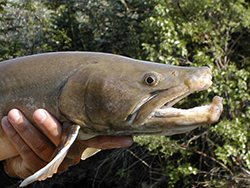 |
How Do I Get Involved?
If you wish to receive NFHAP News via email, please subscribe to the National Fish Habitat Action Plan News list, which currently has over 1,700 users.
Find out if a Fish Habitat Partnership is active in your area. If so, your field office or refuge can propose projects that align with the Partnership’s strategic priorities. If a Fish Habitat Partnership is under development in your area, you could provide data to help it assess the condition of local aquatic resources or identify strategic priorities for the Partnership.
If there is no Fish Habitat Partnership in your area, you could help to start one. Contact your Regional Coordinator for additional information.
How do I start a Fish Habitat Partnership?
Fish Habitat Partnerships must meet certain criteria to be recognized by the National Fish Habitat Board. Anyone interested in establishing a Fish Habitat Partnership (FHP) should read and understand the National Fish Habitat Action Plan and the Guidance for Establishing Fish Habitat Partnerships. If you have questions, you can contact the staff of the National Fish Habitat Board by e-mailing partner@fishhabitat.org.
Extensive efforts are underway to recruit the full range of partner organizations that share in the “community of interest” around which Fish Habitat Partnerships are formed, including non-traditional conservation partners, such as businesses, landowners, and local governments. Prospective Fish Habitat Partnerships should consult with neighboring or overlapping FHPs to clarify their respective roles, priorities, and their geographic scope.
How do I apply for funding?
The Fish and Wildlife Service Manual describes the general requirements, eligibility criteria, and administrative procedures to guide the use of Service funds to implement projects and provide Federal assistance for the National Fish Habitat Action Plan.
Service Regions have considerable flexibility for soliciting and identifying projects. However, all projects must be entered in FONS to be considered for funding. Only projects that address priorities of the Fish Habitat Partnerships will be selected. Any Service Field Office, program, or other appropriate partner can submit fish habitat projects for funding consideration. In general, the annual timeline for identifying and prioritizing projects is shown below. The actual timing of events may vary depending on the appropriations process.
Timeline
| October | The Director:
|
November |
Each Fish Habitat Partnership:
|
December |
Assistant Regional Directors-Fisheries:
|
January |
A national-level project review group comprised of Service staff and Board representatives:
|
February-March |
The Director:
|
April |
The Director:
|
Funding will not all come from USFWS appropriations. Leveraging with our partners (private and public) is very important. Consider working through the National Fish and Wildlife Foundation or other funding entities. Seek out other novel funding sources, such as the Department of Defense or corporate partnerships.


